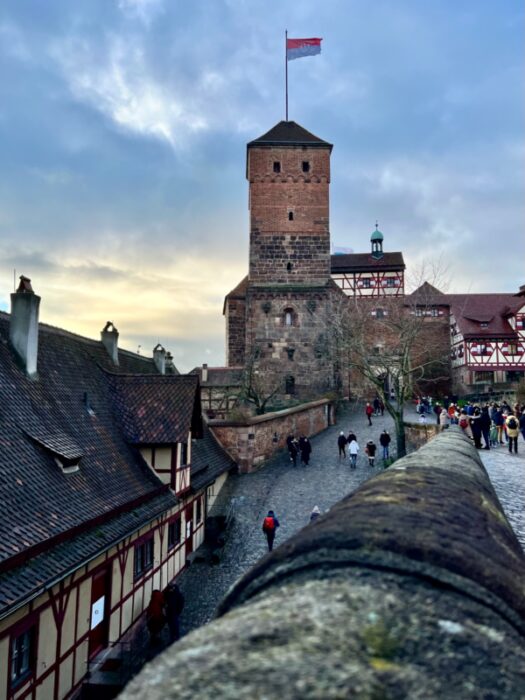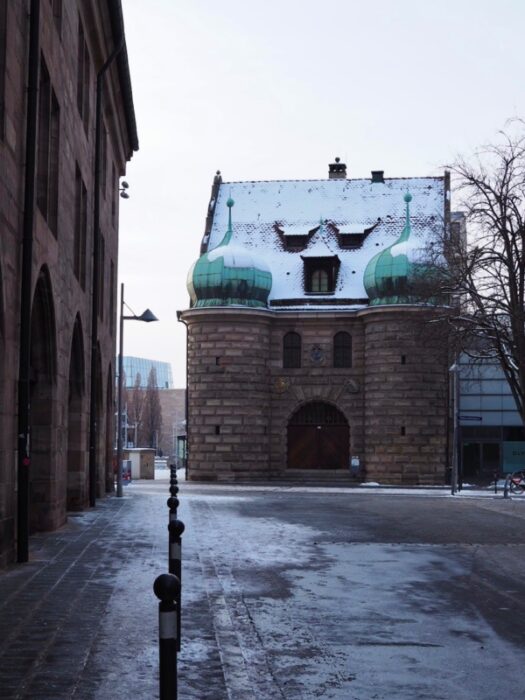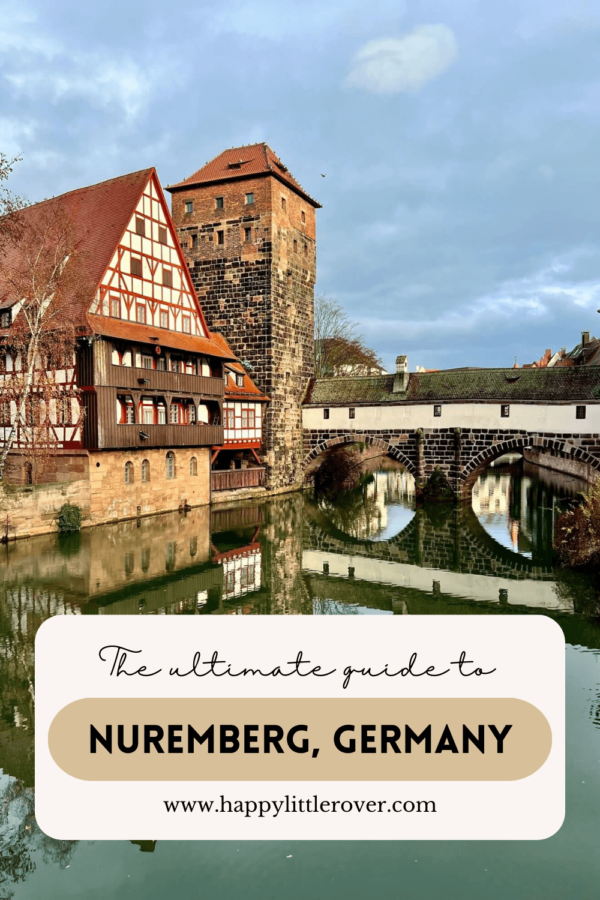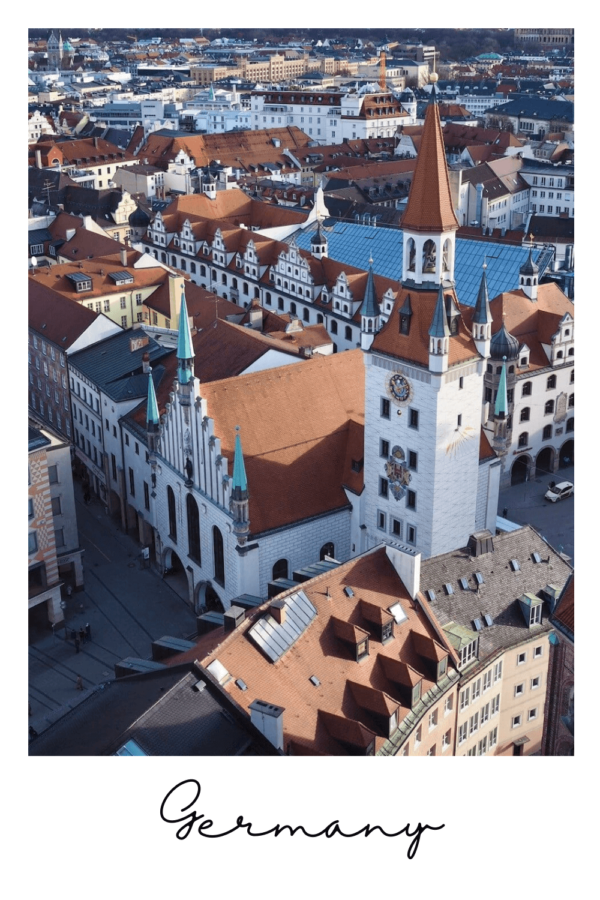Is Nuremberg worth visiting? Your guide to this charming medieval city
Welcome to the stunning Imperial City of Nuremberg, one time castle topped home of Holy Roman Emperors and now a feted destination for the original Christmas market.
But is Nuremberg worth visiting amongst all of the other majestic German cities?
I spent four delightful days in this magnificently medieval city to find out.
Let’s go wandering past delightful half-timbered houses and hunt down the best mulled wine and mini sausages together.



So, is it worth visiting Nuremberg?
If you were to ask someone about the must visit cities in Germany, I’m sure that Berlin and Munich are going to be the top replies.
With such world-famous centres, packed with culture, is it worth visiting Nuremberg?
While each of those magnificent cities has plenty to offer, if you’ve got a bit more time to spend in Deutschland, I would highly recommend stopping for a few nights.
It is absolutely worth visiting Nuremberg to take in the beautifully authentic old town and quaint atmosphere.
Easily accessible via train or bus from Munich and oozing with history, Nuremberg has more than enough happening to keep you entertained for a few days.
You just can’t miss this postcard worthy city, with its charming cobblestone streets lined with pastel half-timbered houses.
Throw in specialty gingerbread, a world-famous Christmas market and traditional pubs serving authentic Franconian cuisine, you’ve got a recipe for a seriously good time in this medieval masterpiece.
Plus it comes with far fewer crowds, especially if you’re visiting outside of peak season.
A bit of history
As I mentioned above, Nuremberg isn’t always high on the list of must visit German cities, especially if you’re asking international visitors.
But in the Middle Ages, Nuremberg was a pretty big deal, the Holy Roman Emperors regularly stopped by and the city enjoyed being an Imperial playground for the rich and famous.
It was the home of the Renaissance in Germany and was generally a cultural powerhouse up until the 1800s.
Without giving you a whole German history lesson, the wealth flowing through the staunch city gates through the centuries led to the magnificent architecture of the city.
Strolling past the enormous Frauentorturm, entering any of the three imposing cathedrals or peering down from the Imperial Fortress, Nuremberg’s history is still a marvel to this day.
The Kaiserberg Fortress or Castle, first built in 1140, sits high on a sandstone ridge above the amber roofs of the city.
Designed to protect Holy Roman Emperors, its four towers and palace building dominate Nuremberg’s skyline.
Hike up the hill to see the panoramic vista from the terrace just outside the castle walls and admire the juxtaposition of the old city against the factories of the new city.
In more recent events, it was an infamous location during the Second World War for rallies and after the conflict of WWII for the Nuremberg Trials.
There are excellent exhibitions dealing with this period of history that are accessible a bit outside of the city centre.


Unfortunately, Nuremberg suffered heavy bombing during WWII, a majority of the Old Town was destroyed due to the large amounts of timber framed houses.
But after the conflict, many of the landmarks were painstakingly reconstructed to their former glory, thanks to tireless restoration efforts.
While this was a tragic time in Nuremberg’s long history, fortunately we stil have the charming Altstadt to explore in the present day.
Top sights worth visiting in Nuremberg
Nuremberg is perhaps best known for the world famous Christkindlmarkt, one of the oldest in Germany. Nestled in the main square, or Hauptmarkt, in front of the Frauenkirche, a festive city of striped stalls is set up.
Whether you’re after handmade Christmas tree decorations, gingerbread or a new nativity set, there’s plenty to catch your eye.
It runs from the Friday before the first Sunday of Advent (so the date changes each year) until the 24th of December.
The perfect spot to grab some Xmas presents if you’re lucky enough to be in Nuremberg during this period.
If you’re not here for the snow dusted markets, is Nuremberg worth visiting?
Don’t worry, even if you won’t be around for the Christmas festivities, this medieval masterpiece still has plenty to offer!
Wondering how to visit Nuremberg in winter? Mulled wine and mini bratwursts await!



The Old Town, divided by the Pegnitz River, is absolutely bursting with must see sights, every street I wandered had me giving my camera a proper workout.
Don’t miss the Heilig-Geist-Spital (Holy Ghost Hospital) stretched out over the river on your way down to the main square.
Built in the 1300s to care for the sick residents of Nuremberg, it’s now an aged care facility and even has a medieval pharmacy attached. I’m pretty sure they’re selling more up to date remedies, less call for leeches these days.
The three main cathedrals are all medieval showstoppers: the Frauenkirche in the main square, St Lorenz’s back towards the train station and St. Sebald’s, dedicated to the patron saint of the city.
While the Frauenkirche is closed for the summer of 2023 for reconstruction, the other two are open to the public and all three have free entry.
From hand carved Gothic altars to 20 metre high religious ornaments, it’s worth popping into each one for a quick look.
These enormous cathedrals might help answer your question: is Nuremberg worth visiting?
Further up the hill, the imposing imperial fortress of the Kaiserburg, looks out over the amber roofs of the city.
Even better, while the fortress buildings are paid entry only, the panoramic terraces, inner courtyard and gardens are all totally free to enter. You can’t miss this stunning view of Nuremberg from above!
On Weißgerbergasse, amble between original pastel hued townhouses lining both sides of the street in a postcard worthy scene.
Be transported back to the Golden Age when Nuremberg was one of the most important cities in the Holy Roman Empire.
Wander down to the Hangman’s House sitting over the river, tucked between weeping willows and wonder at how they fit an entire family into that tiny little cottage.
Though they certainly had peaceful surroundings, I do wonder if the river was as clean back in the Middle Ages.
Keen to see more of this magnificent city? How about my walking tour of Nuremberg
How long to spend in Nuremberg
At a minimum, I would recommend at least 2 days in Nuremberg so you can enjoy some of the key sights.
You will save some time if you’re not keen to see inside the Imperial Fortress or any of the churches. Make sure you get an opportunity to try the bratwurst though!
3 days, ideally 4, will give you sufficient time to enjoy all that Nuremberg has to offer, including more WWII oriented sights.
The former Parade Grounds, for example, lie a distance from the city centre and the medieval attractions that I’ve covered here.
With 4 days up your sleeve, you should have the opportunity to squeeze in a day trip to the charming city of Bamberg or well-preserved medieval village of Dinkelsbühl.



Must eat food in Nuremberg
What about those of us who love to travel with their tastebuds in mind, is Nuremberg worth visiting?
Luckily the city comes with its own culinary delights. Franconian cuisine is very much rib-sticking comfort food but almost all restaurants will have at least a vegetarian option as they become more mainstream in Germany.
If you’re not a carnivore, it will be worth double checking the menu before you go and perhaps looking up some specialty restaurants, there may be limited vegetarian choices.
While English is fairly widely spoken, it’s always a good idea to have Google translate on hand or any specific food allergies are written up in German so a miscommunication doesn’t result in an allergic reaction.
If you’re keen on a particular restaurant for your evening meal, especially in the high season, call up or stop in and make a reservation for your desired time. Some venues may have online booking systems too.
Don’t be alarmed if you’re seated at a shared table, this is quite common in pubs and older venues in Germany and Austria.
The wait staff will keep your orders totally separate and you just need to ask them for your bill when you want to pay. They’ll bring the bill to your table for you to settle up.
In big tourist centres, card payment is often available but it’s always a good idea to carry enough cash on you for your meals. Especially when visiting smaller towns and villages.
Germany hasn’t quite taken to the cashless approach with the same enthusiasm as other countries and smaller spots, like a bratwurst stand, are very unlikely to have card payment at all, having some Euros on hand will solve your street food dilemma!



Nürnberger Rostbratwurst (Grilled Nuremberg Sausages)
While you’re in Nuremberg, you have to try the local sausage variety, the Nürnberger Rostbratwurst. Stereotypically German I know but many regions do have their own speciality wurst!
The mini bratwursts here are about the size of a finger, are made from pork and seasoned with marjoram.
They’re most commonly served three to a bread roll (“drei im weggla”) with mustard on the side, occasionally with sauerkraut.
If you’re buying some from one of the little wurst stands throughout the city, the mustard will be available to add yourself off to the side.
The most famous spot to grab some for yourself is the Bratwursthäusle bei St. Sebald, just off the main square and behind St Sebald’s Church.
Elisen Lebkuchen (Speciality Gingerbread)
Next up on the must-eats is the Elisen-Lebkuchen or Nürnberger Lebkuchen. These large, disc shaped gingerbread cookies are sweeter and more delicate than the cookies you might expect.
They’re made with a wide variety of spices, honey and traditionally no flour, according to the 600 year old recipe.
There’s a legend that a master baker in Nuremberg nursed his daughter back from the brink of death by feeding her these biscuits and so named them after his beloved Elisabeth.
They can be coated in chocolate, sugar or flaked almond.
You’ll find shops selling them throughout the old town, a great option is Gebr. Fraunholz Elisenlebküchnerei, you know it’s their speciality when it’s in the name!
Fränkisches Schäufele (Roast Pork Shoulder)
The final gourmet speciality is the Fränkisches Schäufele or roasted pork shoulder.
Crispy roast pork is served piping hot with tender potato dumplings, sauerkraut and a rich gravy, often made with dark beer.
The crunchy skin gives way to fork tender meat underneath, delicately seasoned and best consumed with a traditional red beer!
Many of the traditional Franconian restaurants serve Schäufele, such as Augustiner zur Schranke, which you can find on Tiergärtnertorplatz.
My top tips for Nuremberg
Nuremberg is the English translation of the actual German name of the city: Nürnberg.
So don’t be alarmed if you can’t find any trains going to Nuremberg and your accommodation seems to be in a strange city! You’ll still be understood if you refer to it as Nuremberg too, locals are used to hearing both versions of the name.
Accommodation will be cheaper outside the medieval walls of the old town, even just one street further back.
While Nuremberg is technically part of the Bavarian state, the local area is called Franconia and they have a subculture separate to that of Munich or up in the Bavarian Alps. As well as local slang and customs.
A Weggla bread roll in Nuremberg is replaced by a Semmel bread roll in Munich, just to give you an example of the differences.
Hopefully these top tips will help you decide: is Nuremberg worth visiting?
How to reach Nuremberg
By train: Nuremberg Hauptbahnhof lies just outside the city walls and is well connected to trains reaching over most of Southern Germany, including regional lines.
By bus: Nuremberg Bus Station is just over the road from the main train station and has local, regional and even international buses.
By plane: Nuremberg Airport is 8km from the city centre and has a limited number of domestic and international flights, including service by some budget airlines.
Munich or Stuttgart Airport will both offer a wider range of connections, double check whether it will be more economical to fly into one of the other airports and journey by train or bus.
Where to stay in Nuremberg
Budget options: $
ibis Nürnberg Hauptbahnhof – part of a chain, located just outside the centre.
Jugendherberge Nürnberg – the former Imperial Stables now converted into a very cool youth hostel.
Middle range options: $$
PrivatHotel Probst – tucked away in the old town, only a few minutes from the main rail station.
Bruderherz – complete with a house brewery and restaurant serving up classics, also in the old town.
Luxury options: $$$
Hotel VICTORIA Nürnberg – neighbouring the Frauentorturm, 120 years of hospitality awaits.
Park Plaza Nuremberg – chic, refined and directly across the street from the main rail station.
So, is Nuremberg worth visiting?
So now that you’re loaded up with all the information on this charming medieval city, I think we can agree that Nuremberg is definitely worth visiting.
Bonus points if you get to experience the magic of the Christmas markets with a steaming cup of spiced Glühwein in hand.
I hope that this mini guide helps you plan the most magical time here and don’t forget your camera for all of those winding streets, lined with pastel half-timbered houses.







